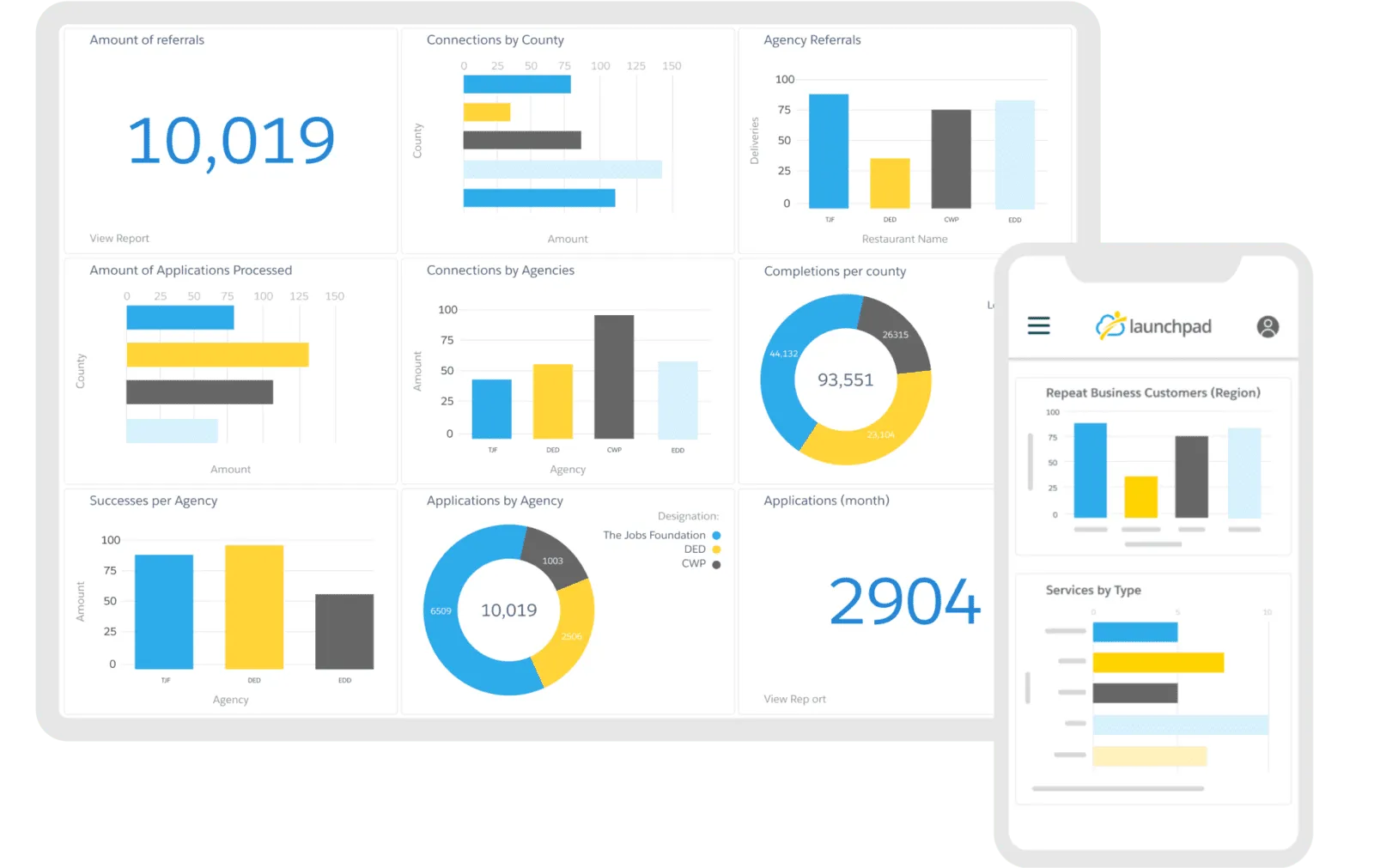Introduction to SalesOps

What is Sales Operations
Sales operations refers to a set of business activities and processes that help a sales organization run effectively, efficiently, and in support of business strategies and objectives. The primary goal of sales operations is to provide the necessary support to enable sales teams to focus more on selling and less on administrative tasks.
This division is typically involved in overseeing the sales administration, ensuring that the sales infrastructure is operating efficiently, and that the business is positioned to grow sales figures based on strategic planning and dedicated sales process.
What Does Sales Operations Do

Sales Operations supports the sales team by providing a range of services and functions that enhance their productivity and effectiveness. Here’s how SalesOps makes a tangible impact:
1. Training and Enablement
SalesOps designs and implements training programs to equip sales teams with the skills necessary to succeed in their roles. This includes everything from product knowledge to advanced sales techniques and the use of sales technology.
For example, implementing regular training sessions can lead to a 40% increase in sales productivity by ensuring that all team members are proficient in the latest sales strategies and tools.
2. Technology and Tools Management
SalesOps oversees the selection and management of technology that supports the sales team. This includes CRM systems, sales automation tools, and performance tracking software.
Implementing a CRM system, for instance, can help increase sales by up to 29%, sales productivity by up to 34%, and accuracy of sales forecasting by 42%.
3. Data Analysis and Reporting
A critical role of SalesOps is to analyze sales data and provide insights that help guide business decisions. This involves tracking key performance indicators (KPIs), sales trends, and market conditions to forecast sales results accurately and plan adequately.
By analyzing sales data, SalesOps can identify patterns and predict future sales trends, helping the company to allocate resources more effectively and adjust strategies in real-time.
4. Performance Measurement
SalesOps is responsible for measuring the effectiveness of the sales organization. This includes setting up sales metrics and benchmarks, monitoring performance, and reporting to senior management on the achievements and areas needing improvement.
Regular performance reviews can lead to a continuous improvement cycle, where sales strategies are refined, and sales team members are held accountable for their results, fostering a culture of excellence and achievement.
What is Sales Enablement
Sales enablement is a continuous and strategic process that prepares all customer-facing employees within an organization to engage effectively and consistently in meaningful conversations with the appropriate customer stakeholders throughout every stage of the customer's problem-solving life cycle, thereby maximizing the return on investment of the sales system.
Essentially, sales enablement is focused on providing sales teams with what they need to successfully engage the buyer throughout the buying process.

Difference Between Sales Operations and Sales Enablement
Sales Operations Roles and Responsibilities

The roles and responsibilities of Sales Operations (SalesOps) are diverse and crucial for the effective functioning of a sales team. Here’s a comprehensive list of typical roles and responsibilities assigned to this function:
1. Strategic Sales Planning
Strategic sales planning is fundamental to ensuring that all sales efforts are in harmony with the overarching objectives of the business. SalesOps teams are crucial in setting these strategic directions.
- Market Analysis: SalesOps conducts detailed analyses of market trends and customer data to forecast potential sales volumes.
- Goal Setting: By defining clear, measurable sales targets, SalesOps provides a roadmap for the sales team. These goals often revolve around revenue targets, customer acquisition costs, and expansion into new markets.
- Resource Allocation: SalesOps ensures that resources such as budgets, sales personnel, and key sales operations tools are allocated efficiently to maximize productivity and achieve sales goals.
- Collaboration with Marketing: SalesOps works closely with marketing to ensure alignment between sales strategies and marketing campaigns, maximizing lead generation and lead quality.
2. Sales Process Optimization
Sales process optimization involves refining the sales cycle to improve efficiency and effectiveness, reducing the time from initial contact to closing a deal.
- Process Mapping and Redesign: SalesOps maps out the entire sales process to identify bottlenecks or inefficiencies. By redesigning these processes, SalesOps can significantly reduce cycle times and improve the customer journey.
- Automation of Sales Tasks: Implementing sales automation tools to handle repetitive tasks such as lead data entry, scheduling of follow-up tasks, and email campaigns. This not only speeds up the process but also allows the sales team to focus more on selling and less on administrative tasks.
- Performance Metrics: SalesOps establishes key performance indicators (KPIs) such as lead conversion rates, average deal size, and sales cycle length. Monitoring these KPIs helps in continuously refining the sales process to meet set benchmarks.
3. Management of Sales Technologies
With the increasing reliance on technology to drive sales, the management of sales technologies is a critical responsibility of SalesOps.
- CRM Systems: SalesOps often takes the lead in selecting and managing Customer Relationship Management (CRM) systems. These systems are vital for tracking interactions with clients, managing sales pipelines, and ensuring that data is accessible and actionable.
- Sales Analytics Tools: Implementing and managing sales analytics tools to derive insights from sales data. These tools help in understanding sales trends, forecasting future sales, and making informed decisions that drive sales effectiveness.
- Training and Support: Providing ongoing training and support to the sales team on how to effectively use these technologies. Ensuring that the sales team is proficient in using the tools at their disposal is key to maximizing their potential benefits.
- Integration of Technologies: Ensuring that sales technologies integrate seamlessly with other systems used by the company, such as marketing automation platforms and customer service software, to create a unified approach to customer management.
4. Data Management and Analysis
Data management and analysis are at the heart of SalesOps, providing the insights needed to drive strategic decision-making and optimize sales performance.
- Collection and Organization: SalesOps is responsible for collecting a wide array of data, from sales results and customer interactions to broader market trends. Organizing this data in a comprehensible and accessible manner is crucial for effective analysis.
- Sales Analytics: Implementing advanced sales analytics tools is key. These tools help analyze data to identify trends, forecast sales, and measure the impact of specific sales strategies. For example, analyzing customer conversion rates can help understand the effectiveness of different sales pitches.
- Reporting: SalesOps teams are tasked with generating detailed reports that provide insights into sales metrics such as sales cycle lengths, conversion rates, and revenue per sales rep. These reports are crucial for tracking the effectiveness of sales strategies and making data-driven decisions.
- Insights and Recommendations: Beyond mere reporting, SalesOps must interpret data to provide actionable insights and strategic recommendations. This might include identifying areas for sales process improvement or opportunities for market expansion.
5. Training and Development
Training and development are essential functions of SalesOps, ensuring that the sales team possesses the skills and knowledge necessary to effectively engage with prospects and close deals.
- Onboarding New Sales Reps: SalesOps typically oversees the onboarding process for new sales representatives, ensuring they understand the company’s sales process, products, and CRM software. Effective onboarding is critical to shorten ramp-up times for new reps.
- Ongoing Training Programs: To maintain a high level of competency, SalesOps organizes ongoing training sessions covering advanced sales techniques, new product updates, and changes in the market or regulatory environment.
- Sales Coaching and Mentoring: Providing one-on-one coaching or group mentoring sessions can be crucial for addressing specific challenges faced by sales reps and aiding in their professional development.
- Evaluation and Feedback: Regular assessments of sales personnel’s performance to provide feedback and identify any further training needs. This ensures continuous improvement and skill enhancement.
6. Compensation and Incentive Programs
Compensation and incentive programs are designed by SalesOps to motivate the sales team and align their goals with the broader objectives of the organization.
- Incentive Plan Design: SalesOps designs incentive programs that are aligned with the company’s strategic goals. This may include commission structures, bonuses, and other performance-related rewards that motivate salespeople to achieve their targets.
- Performance Metrics for Compensation: Establishing clear metrics that determine compensation, such as sales quotas, customer retention rates, and overall revenue contributions. This ensures transparency and fairness in how incentives are awarded.
- Monitoring and Adjusting Compensation Plans: Regularly reviewing and adjusting compensation plans to ensure they remain competitive with the market and effective in motivating the desired behaviors and outcomes.
- Legal Compliance: Ensuring that all compensation and incentive programs comply with relevant laws and regulations to avoid legal issues and maintain ethical standards.
7. Performance Measurement
Performance measurement in Sales Operations is crucial for assessing the effectiveness of sales strategies and the productivity of the sales team.
- Establish Key Performance Indicators (KPIs): SalesOps defines specific metrics such as sales volume, revenue growth, deal closure rates, and customer acquisition costs that are critical for measuring sales success.
- Regular Reporting: Regular generation of performance reports allows for ongoing monitoring of sales outcomes against targets. This is essential not only for gauging the current state of sales but also for planning future strategies.
- Data-Driven Insights: Leveraging data analytics to provide actionable insights. For instance, if sales performance metrics indicate a decline in a particular region, SalesOps might investigate and initiate corrective measures to address this issue.
- Sales Forecasting: Advanced forecasting techniques are utilized to predict sales trends, helping the organization to adapt its strategies in response to projected market dynamics.
8. Resource Allocation
Efficient allocation of resources by Sales Operations ensures that the sales team has the necessary tools and capabilities to achieve their objectives effectively.
- Budget Management: SalesOps manages the sales budget, ensuring funds are allocated optimally across various needs such as sales technology, staffing, and marketing support.
- Tools and Technologies: Allocating up-to-date sales tools and technologies, such as CRM platforms and sales automation tools, to enhance sales productivity and efficiency.
- Talent Allocation: Ensuring the right human resources are in place, including aligning sales territories and reallocating sales reps to maximize coverage and customer engagement.
9. Cross-Functional Collaboration
Sales Operations plays a pivotal role in bridging various departments within the organization to ensure aligned and unified efforts towards common business goals.
- Aligning Sales and Marketing: Ensuring that marketing campaigns are in sync with sales efforts, thus optimizing lead generation and conversion processes.
- Product Development Input: SalesOps provides customer feedback to the product development team, helping shape product innovations and improvements.
- Support Functions: Collaborating with customer support to streamline after-sales service processes, thereby enhancing customer satisfaction and loyalty.
10. Compliance and Governance
Maintaining compliance and governance is essential for Sales Operations to mitigate risks and ensure all sales activities align with legal and ethical standards.
- Regulatory Compliance: Ensuring all sales practices comply with relevant laws and regulations, such as data protection laws and industry-specific compliance requirements.
- Risk Management: Identifying and managing risks associated with sales operations, including financial risks and reputational risks.
- Ethical Standards: Implementing and monitoring ethical standards in sales practices to maintain trust and integrity in customer relationships.
Sales Operations Team Structure

The structure of a Sales ops teams can vary depending on the size of the company, the complexity of the sales processes, and the specific needs of the business. However, a typical Sales Operations team includes several key roles and functions to optimize the sales process and drive business growth. Here's an overview of a common Sales Operations team structure:
- Director of Sales Operations: This is the leader of the team, responsible for overseeing all aspects of sales operations, including strategy, planning, and overall execution. They ensure alignment between the sales operations and the company's business goals.
- Sales Operations Manager: Managers handle the day-to-day management of the sales operations team. They implement strategies designed by the director, manage team members, and report on the team's progress.
- Sales Operations Analyst: Analysts are responsible for data management and analysis. They collect and analyze sales data to identify trends, forecast sales, and provide insights that help in strategic decision-making.
- CRM Administrator: This role focuses on managing and optimizing the Customer Relationship Management (CRM) system. They ensure the CRM supports sales processes effectively, is user-friendly, and is integrated with other tools and systems.
- Deal Desk Coordinator: This role is crucial in managing the configuration, pricing, and quoting (CPQ) processes. They ensure that sales quotes and contracts are accurate and aligned with company policies.
- Sales Enablement Specialist: These specialists focus on training and equipping the sales team with the necessary tools, resources, and information to effectively sell the products or services. They manage training sessions, content creation, and performance analysis.
- Sales Operations Coordinator: Coordinators handle administrative tasks such as scheduling meetings, managing sales documents, and supporting the sales team with necessary logistical details.
- Revenue Operations Specialist: Sometimes part of sales operations, they focus on optimizing revenue strategies. They work closely with sales, marketing, and customer success teams to improve the customer journey and increase revenue.
16 Expert Strategies for Sales Ops Team

Here are 25 best sales operations strategy that can significantly improve the performance and strategic impact
1. Integrate CRM Systems Fully
Ensure the Customer Relationship Management (CRM) system is fully integrated into daily sales activities, providing a central platform for managing customer interactions, sales pipelines, and data storage.
Regularly train sales staff on the optimal use of the CRM system to ensure they are utilizing all features that can enhance productivity and customer engagement.
2. Leverage Data Analytics
Utilize sales data to make informed strategic decisions. This involves analyzing sales trends, customer behavior, and market conditions to forecast sales and adjust strategies accordingly.
Develop comprehensive dashboards and regular reports that provide insights into key performance indicators (KPIs), helping identify successes and areas for improvement.
3. Streamline Sales Processes
Map out all sales processes to identify redundancies and gaps. Simplify and streamline these processes to reduce cycle times and remove inefficiencies.
Implement automation tools to handle routine tasks like lead scoring, data entry, and follow-ups, freeing up sales reps to focus on closing deals.
4. Develop and Update Sales Playbooks
Create detailed sales playbooks that provide guidelines on handling different selling situations, including how to approach different customer segments and respond to common objections.
Regularly update the playbooks based on new insights and feedback to keep the strategies fresh and relevant.
5. Enhance Training and Development
Streamline the onboarding process for new sales reps to shorten the learning curve and help them become productive quickly.
Offer continuous training opportunities focusing on new sales techniques, product updates, and competitive strategies to keep the team agile and knowledgeable.
6. Set Realistic but Challenging Goals
Set clear, measurable, and attainable sales targets that motivate the team but are still achievable. Use historical data and market analysis to set these goals.
Align incentives with these targets to encourage outstanding performance and reward achievements.
7. Foster Cross-Functional Collaboration
Enhance collaboration between the Sales Ops, marketing, customer service, and product development teams to ensure aligned objectives and seamless customer experiences.
Create channels for regular feedback across teams to refine strategies and address any issues promptly.
8. Focus on Customer Success
Shift focus towards customer success as a primary metric. This involves understanding customer needs deeply and aligning sales strategies to solve customer problems effectively.
Build strategies around fostering long-term relationships with customers, which can lead to repeat business and referrals.
9. Optimize Sales Territory Management
Ensure sales territories are optimally assigned based on market potential and sales rep workload. Use geographic data and customer segmentation to create balanced territories that maximize coverage and minimize travel time.
Regularly review and adjust territories based on changing market conditions and sales performance data to keep territories equitable and productive.
10. Implement Advanced Pricing Strategies
Develop pricing strategies that reflect the value delivered to different customer segments and adapt to market dynamics. Use data analytics to understand price sensitivity and competitive positioning.
Standardize discounting processes to maintain profitability and market competitiveness. Empower Sales Ops to monitor and approve discount levels to avoid excessive discounting practices.
11. Enhance Forecasting Accuracy
Utilize advanced predictive analytics tools to improve the accuracy of sales forecasts. Incorporate historical sales data, market trends, and economic indicators into forecasting models.
Regularly conduct scenario planning exercises to prepare for various market conditions. This helps in adjusting strategies swiftly in response to unforeseen changes.
12. Strengthen Lead Management Processes
Develop robust criteria for lead scoring and prioritization to ensure that sales efforts are focused on high-potential leads.
Implement lead nurturing programs that engage potential customers at various stages of the sales funnel, using personalized communications to advance them towards a sale.
13. Promote Sales and Marketing Alignment
Establish shared goals and KPIs for both sales and marketing to ensure mutual accountability and focus on common objectives.
Facilitate regular meetings between sales and marketing teams to discuss strategies, share insights, and coordinate on lead generation and follow-up activities.
14. Leverage Contract Management Tools
Introduce tools that automate and manage contract creation, negotiation, and storage. This reduces the administrative burden on sales reps and speeds up the sales cycle.
Use these tools to ensure contract compliance and timely renewals, which can help maintain customer relationships and revenue streams.
15. Invest in Sales Enablement Platforms
Deploy sales enablement platforms that organize and provide easy access to sales content like presentations, proposals, and product sheets tailored to different stages of the buyer's journey.
Utilize features within these platforms for ongoing sales training and coaching, making it easier to disseminate best practices and new information across the team.
16. Develop a Comprehensive Performance Management System
Implement a structured performance review system that regularly assesses sales rep achievements against goals, providing a basis for feedback and professional development.
Design incentive structures not just around sales quotas but also customer satisfaction scores, retention rates, and other strategic metrics.
Sales Operations Teams Processes

To optimize the performance and impact of Sales Operations teams, a structured and systematic approach is essential.
Here, we detail a step-by-step process for refining Sales Operations team processes
Step 1: Define Strategic Objectives
Begin by ensuring that the sales operations strategy aligns with the broader business goals. This involves defining clear objectives that support overall company targets, such as increasing sales productivity, optimizing the sales process, and enhancing customer relationship management.
Establish Key Performance Indicators (KPIs) like sales cycle length, conversion rates, and customer acquisition costs to measure the success of the sales operations strategy.
Step 2: Map Existing Sales Processes
Map out all existing sales processes including lead management, sales forecasting, customer engagement, and sales closure. This helps identify any inefficiencies or gaps in the current sales operations.
Use data analytics to assess the effectiveness of these processes. Look at metrics such as lead conversion rates and average sales cycle times to determine areas needing improvement.
Step 3: Implement Process Improvements
Based on the analysis, streamline processes by removing redundancies and implementing best practices. Focus on areas like sales process optimization, lead scoring systems, and sales technology utilization to improve efficiency.
Introduce automation tools to handle repetitive tasks such as data entry, lead nurturing, and initial customer communications. This frees up sales reps to focus on more strategic activities.
Step 4: Enhance Sales Technology Integration
Ensure the Customer Relationship Management (CRM) system is fully utilized and integrated with other sales tools for seamless operation. This integration supports activities such as sales forecasting, customer data management, and performance tracking.
Leverage advanced sales operations tools like AI for predictive analytics and machine learning for deeper customer insights and behavioral forecasting.
Step 5: Develop Training and Support Structures
Implement ongoing training programs that cover new sales tools, advanced sales techniques, and updates on the product or service offerings to ensure the sales team is always at the cutting edge of sales knowledge.
Provide continuous support and resources to the sales team, including access to sales enablement materials and expert advice, to assist them in meeting their sales targets.
Step 6: Foster Cross-Functional Collaboration
Strengthen collaboration between the sales operations team and other departments such as marketing, product development, and customer service. This ensures that all teams are aligned and can support the sales process effectively.
Set up regular inter-departmental meetings to discuss strategies, share updates, and resolve any issues promptly. This helps maintain a unified approach to achieving company-wide goals.
Step 7: Monitor, Analyze, and Refine
Regularly monitor the performance of sales operations using the defined KPIs. Utilize sales analytics tools to get real-time insights into what is working and what isn’t.
Encourage feedback from the sales team on the ground and iterate on processes based on this feedback. Continuous improvement should be a key part of the sales operations strategy to adapt to changing market conditions and internal company dynamics.
How to Build an Effective Sales Ops Team

Building an effective Sales Operations department requires strategic planning, precise execution, and ongoing management to ensure that it supports the sales team's needs and contributes to the overall success of the company.
Here’s a detailed guide on how to construct a robust Sales Ops team:
Step 1: Define the Role and Objectives of the Sales Operations Department
Begin by clearly defining the role of the Sales Operations department within your organization. Understand that this department is crucial for streamlining sales processes, enhancing sales strategies, implementing technologies, and analyzing data to support the sales team.
Determine the specific objectives that the Sales Operations department needs to achieve. These might include increasing sales efficiency, reducing the sales cycle length, improving forecast accuracy, or enhancing the customer acquisition process.
Step 2: Identify Key Functions and Responsibilities
- Process Management: The Sales Ops team should be responsible for designing and implementing efficient sales processes from lead generation to closing deals.
- Data Management and Analytics: Managing sales data and providing actionable insights are fundamental roles. This includes data collection, analysis, and reporting to guide strategic decisions.
- Technology Implementation and Management: Oversee the selection and integration of sales technologies like CRM systems, data analytics tools, and automation software.
- Training and Support: Develop and manage training programs for sales staff to ensure they are proficient in using new technologies and methodologies.
Step 3: Structure the Team
Depending on the size and needs of your business, the Sales Ops department might include roles such as a Sales Operations Manager, CRM Administrator, Data Analyst, and a Training Coordinator.
Design the team structure with scalability in mind. As the company grows, the Sales Ops team should easily integrate new roles or expand existing ones without disrupting ongoing operations.
Step 4: Hire the Right Talent
Identify the skills and experience required for each role within the department. Look for candidates with a mix of analytical prowess, technical skills, and a deep understanding of sales processes.
Ensure that new hires align with the company culture and possess the collaborative spirit necessary for cross-functional work.
Step 5: Integrate Sales Operations with Other Departments
Establish strong communication channels and regular interaction between the Sales Ops team and other departments such as Marketing, Finance, and Customer Service. This ensures that Sales Ops strategies align with broader company objectives and market conditions.
Implement systems to gather feedback from the sales team and other departments to continuously refine processes and technologies based on real-world insights and needs.
Step 6: Implement Training and Development Programs
Provide comprehensive training for new hires and ongoing education for all team members to keep them updated on new sales methodologies, technologies, and market trends.
Encourage and support professional development to help team members advance their skills and careers, which in turn benefits the department and the company.
Step 7: Monitor Performance and Optimize Continuously
Establish clear metrics to measure the effectiveness of the Sales Operations department. Regularly review these metrics to assess whether the team is meeting its objectives.
Leverage insights from performance data to make informed adjustments to processes, strategies, and technologies. Encourage a culture of innovation and continuous improvement within the team.
Best Tools and Technologies for Sales Operations
To optimize sales operations, leveraging the right tools and technologies is crucial. These solutions enhance efficiency, accuracy, and productivity across the sales process, from lead management to closing deals.
Here's a list of the best tools and technologies that can empower a sales operations team:
1. Customer Relationship Management (CRM) Systems

- Salesforce: One of the most widely recognized CRM platforms, Salesforce offers extensive customization, integration options, and robust sales management features.
- HubSpot Sales Hub: Ideal for businesses looking for a user-friendly interface with powerful sales automation, reporting, and integration capabilities.
- Microsoft Dynamics 365: A versatile CRM solution that integrates deeply with other Microsoft products, making it ideal for companies already within the Microsoft ecosystem.
2. Data Analytics and Reporting Tools

- Tableau: Known for its advanced visualization capabilities, Tableau helps sales teams to turn complex data sets into actionable insights.
- Power BI: A Microsoft product that integrates well with other Windows applications and provides comprehensive analytics and business intelligence solutions.
- Looker: Now part of Google Cloud, Looker supports data exploration and insightful analytics, providing customized reporting options.
3. Sales Automation Tools

- Outreach: A sales engagement platform that automates and sequences email and communication tasks, helping sales teams focus more on selling and less on admin.
- Salesloft: Provides a powerful suite of sales engagement tools that facilitate better interaction with prospects through streamlined communication workflows.
4. Email Management and Tracking

- Yesware: Embeds directly into your email client and provides tools for email tracking, analytics, and automation, enhancing sales communication.
- Mailchimp: While traditionally viewed as a marketing tool, Mailchimp’s robust automation features can be effectively utilized for sales operations to manage outreach campaigns.
5. Contract Management
- DocuSign: An industry leader in digital signature technology, DocuSign streamlines the contract signing process, significantly speeding up sales cycles.
- PandaDoc: Allows sales teams to create, manage, and sign digital documents efficiently, including proposals, quotes, and contracts.
6. Lead and Sales Prospecting Tools

- LinkedIn Sales Navigator: Offers advanced search capabilities, lead recommendations, and real-time insights on existing accounts and contacts.
- ZoomInfo: Provides access to a vast database of B2B contact information, which can help sales operations teams to pinpoint and reach out to potential customers.
7. Training and Development Platforms
- MindTickle: A sales readiness platform that provides tools for onboarding, micro-learning, skills development, and coaching.
- Lessonly by Seismic: Offers simple, effective tools for training and coaching sales teams, ensuring they're prepared to meet their sales objectives.
8. Performance Management Systems
- Xactly: Specializes in sales performance management, offering tools for planning, incentivizing, and optimizing sales team performance.
- Clari: Combines revenue operations with AI to provide forecasting and pipeline management solutions, giving clearer visibility into sales performance.
Concluding Thoughts
In conclusion, for sales managers aiming to rapidly accelerate their pipeline, employing a strategic and robust approach to managing your Sales Operations team is imperative. The strategies outlined provide a comprehensive framework that not only addresses the foundational aspects of sales operations—such as strategic planning, process optimization, and technology integration—but also highlights the importance of continuous improvement and cross-functional collaboration.
By embracing these expert strategies, sales managers can ensure their teams are equipped to respond dynamically to changing market conditions, driving both efficiency and growth. Implement these tactics diligently to transform your sales operations into a powerhouse that significantly contributes to the bottom line.
Further Reading
To further enhance your understanding of how to rapidly accelerate your sales pipeline and refine your sales operations strategies, consider exploring the following resources on our blog. These articles offer additional insights and practical advice to improve the effectiveness of your sales funnel and drive greater efficiency in your sales operations:
- Discovery Questions to Uncover Customer Needs: Learn the art of asking the right questions during the discovery phase to better understand potential customers' needs and tailor your sales approach accordingly.
- How the SPICED Model Can Help You Close Sales Effectively: Dive into the SPICED model to enhance your sales techniques and close deals more effectively by focusing on Situation, Pain, Impact, Critical Event, and Decision.
- Strategies for Sales Acceleration: Explore advanced strategies for accelerating your sales processes, helping you shorten the sales cycle and increase your conversion rates.
- Mastering Qualifying Questions to Identify Sales-Ready Leads: Gain insights into crafting effective qualifying questions that help you quickly identify the most promising leads, saving time and focusing resources on high-potential opportunities.
- Inside vs Outside Sales: Choosing the Right Strategy for Your Business: Understand the differences between inside and outside sales and determine which strategy best aligns with your business objectives and customer engagement methods.
These resources are designed to provide you with a deeper understanding of effective sales operations practices and introduce you to advanced techniques that can supercharge your team's performance. By incorporating these insights into your strategy, you can ensure that your Sales Ops team is well-equipped to support accelerated growth and enhanced pipeline efficiency.








